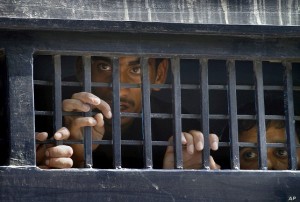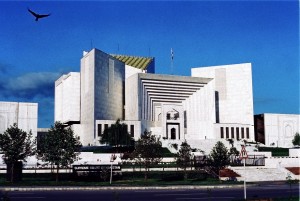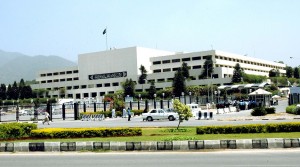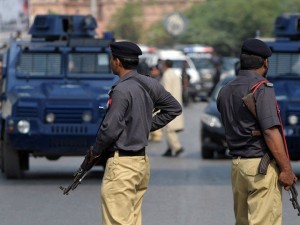Criminal Justice System of Pakistan
Kamran Adil
In 2016, the syllabus for Central Superior Services (CSS) Examination was revised by the Federal Public Service Commission (FPSC). The revision was not perfect and was inchoate in the sense that it did not attend to qualitative aspects of the examination. It, however, offered the new subject of criminology that provided the candidates option to read an empowering and socially-relevant field of study. In the instant adumbration, an attempt has been made to present basic details of the criminal justice system of Pakistan in original, precise and updated manner.There are different ways to describe the criminal justice system of Pakistan. This write-up will present the material in thematic manner and will try to link it with the constitution to contextualize the discussion. The topical treatment is as under:
- Constitution of Pakistan and Judicature
The constitution of a country constitutes its basic organs, i.e. legislature, executive and judicature. The 1973 Constitution of Pakistan, like its predecessor constitutional instruments, provides for the three organs. As Pakistan is a Federation, its constitution provides for executive, legislature and judicature at both federal and provincial levels. Part VII of the Constitution provides for judicature. It must be noted that the concept of judicature is often confused with the term judiciary; while, the judicature means the administration of justice, the judiciary is the system of courts in a country.
- Judicature and Criminal Justice System
Part VII of the Constitution of Pakistan provides for separation of judiciary from executive (Article 175). This separation is a constitutional dictate which has yet to witness fruition. The traditionally strong executive has remained central to power, and has kept the legislature and the judicature peripheral by controlling the purse. Since 2007, the judiciary has gained some space by using its suo motu powers (Article 184(3)) to enforce fundamental rights coupled with its power to punish contempt or non-observance of its orders (Article 204); the legislature has not been able to assert its power through its conventions and privileges rules and due to its partisan nature. The Constitution constitutes the constitutional courts of Supreme Court, High Courts and Federal Shariat Court, and provides for constitutional, civil, criminal and service matters related jurisdictions of different courts. The cumulative reading of competence of federal and provincial legislatures, the jurisdictions of constitutional courts and the fundamental rights (Articles 4, 6, 8, 9, 10, 10-A, 11, 12 and 13) provide for the constitutional basis of the criminal justice system in Pakistan.
- Role of Federal and Provincial Governments and Criminal Justice System
Under the constitution, maintaining the law and order is the responsibility of the provinces that discharge it through the provincial governments. In the provinces, the criminal justice system is managed through the home and prosecution departments. The responsibility of the federation is concurrent to the provinces (Articles 142 and 143) and extends to federally-administered territories of the Islamabad Capital Territory (ICT), the Gilgit-Baltistan (GB), and the Azad Jammu and Kashmir (AJK). The federal government is also responsible for dealing with inter-provincial coordination in criminal matters that it carries out through the Ministry of Interior (MoI). In addition, the federal government has power over the Federal Investigation Agency (FIA) which functions as a federal police, and investigates and prosecutes organized crimes of illegal immigration, human trafficking, cybercrime, etc. The federal and provincial governments use their respective rules of business to exercise superintendence of the criminal justice system; this use of delegated legislation to counterweight the primary legislation is an important mechanism that must be researched thoroughly to bring about any reform in the system of governance of the criminal justice system.

- Criminal Justice System
Ontologically, the study of crimes is styled as ‘Criminology’ and the study of the agencies that control or respond to crime is called Criminal Justice (CJ). The US has rich tradition in knowledge production of CJ and offers its separate degree programmes. Based on the US pedagogical practice, the criminal justice system of Pakistan may be divided into five components: (i) Police, (ii) Prosecution, (iii) Courts; (iv) Prisons and (v) Corrections. Each component has its own functions, organization, budget, working and legal framework. In practice, a typical provincial criminal justice system is managed by the Home Department under which the police and prisons work as its attached departments. Due to paucity of space, brief introduction to each component is given hereunder:
- Police
According to the Oxford Handbook on Criminology, police is an organization, whereas policing is the function of preventing and detecting crime. In Pakistan, insofar as organizational aspect is concerned, each province has its own police organization like Punjab Police, Sindh Police, KP Police and Balochistan Police. The total number of police personnel is about half a million. Each province has its own organizational law. The Police Order, 2002, is the organizational law of the Punjab Police, the KP Police Act, 2017, is the organizational law of the KP Police, the Sindh Police works under the Sindh (Repeal of the Police Act, 1861 and the Revival of the Police Order, 2002) (Amendment) Act, 2019, and the Balochistan Police uses the Balochistan Police Act, 2011. The powers of policing are provided by the Code of Criminal Procedure and all police organizations derive their policing powers from it. The legal framework of policing primarily supports detection model by providing legal basis of investigation and subsequent processes; it provides very limited powers of preventing crime to the police organizations.
- Prosecution
The function of the prosecution is to evaluate the evidence collected by police, and to filter the quality and quantity of cases to be sent up for trial. Historically, it was part of police organizations. Following the example of the United Kingdom, where the UK Crown Prosecution Service (CPS) was founded in 1986, the prosecution was first time separated from police organizations in 1986, but the arrangement was reversed in 1991. Thereafter, in 2003, separate prosecution departments/attached departments were established in all the provinces. The organizations and functions of prosecution departments are governed by separate provincial laws. Punjab Prosecution Department was established in 2006 under the Punjab Criminal Prosecution Service (Constitution, Functions and Powers) Act, 2006, the Sindh Prosecution Service works as an attached department of the Sindh Law Department and its working law is the Sindh Criminal Prosecution Service (Constitution, Functions and Powers) Act, 2010. Likewise, with some variations, the KP Prosecution Service (Constitution, Functions and Powers) Act, 2005, and the Balochistan Prosecution Service (Constitution, Functions and Powers) Act, 2003 establish prosecution organizations in the KP and Balochistan.
the courts that deal with criminal matters are magistrate and sessions courts. In contradistinction to the constitutional courts that are established under the constitution and have the binding effect on all the executive, the magistrate and sessions courts are products of the Code of Criminal Procedure, and are essentially courts to decide facts. The magistrates have the charge of different police stations and their working is as important as of police stations. Owing to their significance, the Chief Justice of Pakistan, Mr Justice Asif Saeed Khan Khosa called the police and courts as ‘conjoined twins’. The courts have to adjudicate the criminal matters by conducting trials in accordance with the extant law. The courts of magistrates and additional sessions are present at the level of tehsil/taluka in every district of the country. All the accused have to be produced before them within twenty-four hours in accordance with the constitution (Article 10). The courts follow adversarial system of adjudication. The criminal cases are to be proved beyond any shadow of doubt and the accused is treated as innocent unless proven guilty.
- Prisons and Corrections
The prisons work as an attached department to provincial Home Departments. Maintaining an incarceration-based prison system is a very expensive project for any economy. All over the world, the trend is to minimize the burden on prisons. In Pakistan, conceptually, every district should have a district prison and for every division, there should be a central prison; but, in practice, the district and central jails have not been provided to all districts and divisions of the country. The legal framework of prisons is very old in the whole country; the prisons in all the provinces are constituted, and function, under the Prisons Act, 1894, save Sindh where the Sindh Prisons and Corrections Services Act, 2019, has been enacted recently. The prison departments in Pakistan also contain the corrections facilities that are aimed at providing skills to the prisoners so that they can rehabilitate in society on their return. Unfortunately, due to low levels of investment in corrections, the results of the corrections system are limited and their facilities are virtually merged into prisons establishments. The regime of parole and probation that work as alternatives to imprisonment was introduced in 1927 through the Directorates of Parole and Probation under Home Department. After Independence, such directorates were introduced in all the provinces within the Home Departments. For the sake of knowledge and in the context of Pakistan, definitions of three key terms related to rehabilitation and reintegration must be noted:
- Corrections: “…services and programs aimed at correcting the criminal conduct of the Prisoners in order to rehabilitate and integrate them in the society” (Section 4(l) of the Sindh Prisons and Corrections Services Act, 2019);
- Probation: The term probation is based on two laws titled as the Good Conduct Probationer’s Release Act, 1926 and the Probation of Offenders Ordinance, 1960. The concept of probation is that first time offenders may be released by the court on surety. Probation may be applied as an alternate to imprisonment.
- Parole: The term parole is not defined in the law. The Good Conduct Probationer’s Release Rules, 1927 refer to Parole Officers who supervise the prisoners on ‘parole’. The concept is that the provincial governments may suspend the sentence of a prisoner and release him under a licence due to his good behavior.
 Jahangir's World Times First Comprehensive Magazine for students/teachers of competitive exams and general readers as well.
Jahangir's World Times First Comprehensive Magazine for students/teachers of competitive exams and general readers as well.







